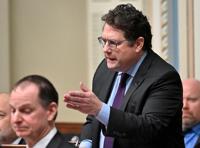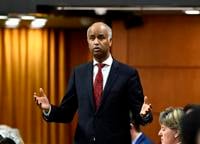YOUNGSTOWN, Ohio - When Donald Trump joked with supporters in Ohio that Republican Senate hopeful J.D. Vance had been "kissing my ass" for an endorsement, you could almost hear the snorts of delight from rival Tim Ryan's campaign staff.
For Democrats, the payoff came last week when Ryan and Vance squared off in their first and only televised debate of the 2022 midterms.
"I don't kiss anyone's ass, like him," Ryan sneered, jerking a thumb towards his opponent, near the end of an hour-long exchange that otherwise seemed civil ã tame, even ã by modern standards.
"Ohio needs an ass kicker, not an ass kisser."
Like so much of what comes out of Trump's mouth at his rallies, it's hard to gauge whether the Sept. 17 remark ã a rebuttal to media reports that he'd become a liability on the campaign trail ã had much impact.
But it illustrates a peculiar inversion of this midterm season: Democrats and Republicans would rather talk about each other's leaders than their own.
Across the Mahoning Valley, a rolling, fertile tract of northeast Ohio that's home to the hardscrabble industrial city of Youngstown, Joe Biden's thumbs-up likeness looks down from countless roadside billboards ã Republican ones deriding him.
By contrast, pro-Democrat advertising is all but invisible throughout the region, testament to how much of a burden the president has become to the party in its midterm effort to retail control of the House and the Senate.
Biden ran on a promise to bring the country together, only to turn around earlier this year and attack what he called "MAGA Republicans," Vance said ã a potent charge in a state where Trump proved popular in both 2016 and 2020.
"The end result of Joe Biden's policies, and the end result of his rhetoric, is that we hate each other a lot more than we did two years ago," Vance said.
"That's a significant failure of leadership."
That hasn't prevented Biden from trying to shore up support in the state, where he's been making the case that Ohio stands to benefit from two of his signature legislative wins: the CHIPS and Science Act and the Inflation Reduction Act.
He credits the former, a multibillion-dollar package of incentives to foster domestic semiconductor development and manufacturing, for a brand new $20-billion Intel facility in Ohio. Once complete, it will create 3,000 full-time jobs paying an average of $135,000 a year ã "and not all of them will require college degrees once these facilities are built," Biden said during last month's groundbreaking.
Last week, another victory lap, this one courtesy of the Inflation Reduction Act, which fosters the manufacture and sale of electric vehicles: Honda and LG teaming up to spend more than $5 billion on a new battery plant in the state and retool existing facilities.
"This has been the backbone of my economic plan," Biden said. "America is leading the world again, rebuilding our supply chains, infrastructure, and manufacturing here at home."
All of it may be for naught, however, if voters don't turn up at the polls ã a potentially serious problem for Democrats in a part of the country battered by, and weary of, the constant political push and pull.
The turmoil of 2020 "has left a lot of people exhausted," said John Jarvis, a retired firefighter and lifelong Youngstown resident as he relaxed at a local beer hall Saturday with his wife and eight-month-old Thurman, a golden retriever puppy.
That's why the couple, who self-identify as Democrats, have paid "no attention at all" to the midterms, still weary of the tensions of two years ago, said Jarvis's wife, Laura.
"At work, it's very torn one way or the other between one side that wants Trump versus Biden."
Ohio has in recent years become a study in political contradictions.
In two successive presidential elections, Donald Trump bested his Democratic rivals by more than eight per cent in the state, which also opted for Barack Obama twice in 2008 and 2012, albeit by smaller margins.
"This area was a very, very strong Democrat area for a long, long time," said Jarvis. "I think that swayed a little bit with Trump. Now, I'm not real sure."
Ohio is also home to Democrat Sen. Sherrod Brown, a 15-year veteran of the upper chamber that Ohio State University politics professor Paul Beck describes as "among the most liberal members of the U.S. Senate."
Beck bristles at the suggestion that Ohio is now Republican territory: "It's not as if Republican presidential candidates have turned Ohio into a red state."
But Ryan ã since 2003 a congressman who grew up near Youngstown in the region he represents, which has been hit hard by the steady decline of the manufacturing and steel sectors in the U.S. Midwest ã has nonetheless adapted a political style more sympathetic to the former president than the current one.
"I've run against Nancy Pelosi, I have taken on Bernie Sanders, I have opposed Joe Biden on numerous pieces of legislation that he wants to try to promote and push," Ryan said during the debate.
"And I've agreed with Donald Trump on trade, renegotiating NAFTA, being firmer on China, defence, General Mattis being secretary of defense and all the rest."
Despite his opposition to NAFTA, an essential position for any Ohio politician, Beck said he would expect Ryan to be an ally to Canada, given the key role the state plays in the highly integrated cross-border auto sector.
"Ryan has always spoken favourably about trade with Canada," Beck said.
"The part of Ohio that he's from ã and certainly the part of Ohio that is closer to Detroit and Windsor and that part of Canada ã has been very dependent upon agreements between Canadian and American investors and companies in the automotive (industry)."
Undecided voters represent roughly 10 per cent of the electorate, recent polls suggest ã which is why Ryan's debate-night dig at Vance over his fealty to Trump could well have done some damage, Beck said.
"It could move independents and people who are maybe reluctant Republicans into the Ryan column," he said.
"Of course, he has courted them and tried to go after them and persuade them that he is not your vintage Democrat, but somebody that they indeed can vote for."
This report by üСÜꪤüýò¿Øéóæòêü was first published Sunday, Oct. 16, 2022.








































